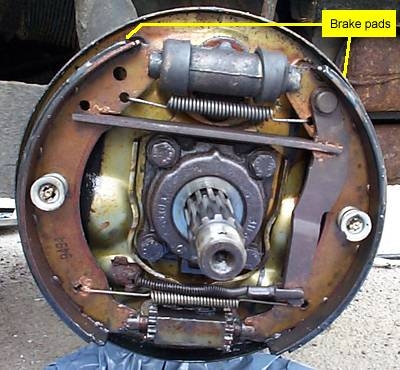
Volkswagen Beetles, commonly known as "Bugs", were designed with four-wheel drum brakes that can be easily changed when they wear out. It should take about two hours to repair the worn brake shoes and cylinders.
Jack up the vehicle and remove one wheel. Once the wheel is off, there will be a round drum brake cylinder visible. It should pull off easily, unless it is overly rusted.
Remove the tension springs holding the brake shoes in place. The specialized tool can be inserted at the end of the spring, sliding it down and away from the clip. Some packages of brake shoes and parts come with replacement springs, but the old ones can be reused if they still hold tension.
Remove the brake shoes from both sides of the brake assembly. Without the springs, they should slide away from the assembly, horizontally. Check for excessive wear, or glazing, and then replace with new shoes.
Reinstall the tension springs. Place the lower end of the spring into the assembly's clip, then slide the top spring hook onto the upper clip using the tool. The shoes should be pulled in towards the center.
Check the wheel cylinders for leakage. These are small cylinders located on top of the brake assembly between the shoes. The rubber seal around the edge of each cylinder will degrade and leak after several years, especially if the Bug has not been driven. Replacing these cylinders is not difficult, but time consuming and messy.
Check the condition of the drum cylinders, and "turn" them, if necessary. "Turning" a drum cylinder is placing it onto a lathe and scraping off the wear and corrosion. Most auto parts stores and brake shops provide this service for a small fee, but none will turn them if they are too badly worn. There is a standard thickness that must remain on the cylinder's inner wall to safely reuse them. If they cannot be reused, then they must be replaced. Repeat steps 1-6 for the brakes on the remaining wheels.
Bleed the braking system at the master cylinder, once all shoes have been replaced. In some Volkswagen vehicles, the type of master cylinder may vary, but for most Beetles (pre-1975) it is directly attached to the brake pedal, in front of the floor pan. Using the universal bleeding kit, pressure bleed the system according to the instructions provided. Loosen the "bleeding nipple" on the top back side of the brake, behind the wheel cylinder, before pressurizing the master cylinder. Each brake line must be bled individually. Once all of the air has been purged from the system, the brake pedal should have a good amount of resistance and stop the vehicle smoothly.